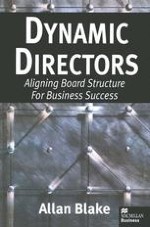The leadership that a board of directors and its individual directors provides has a profound affect on the future of a company in terms of its performance and success. Whilst much has been written about corporate governance little has been written about the dynamics of board architecture, yet the board is a key decision-making body within a company. In this book, the author shows how board members, consultants and policy-makers need to understand the complexity of board architecture, recognising that directors and their leadership skills are dependent on the type of company and its stage of development. Operating at board level is never easy. This book can help to explain why and assist in altering a company's approach to one that is more successful. Just as you may undertake an analysis of the personality type of the various people that you deal with in a client company, the author argues that you can also undertake an analysis of the company at board level. Dynamic Directors provides an invaluable guide to assisting in the development of boards and in showing how successful board development can lead to successful companies, be they family run, entrepreneur, subsidiary or companies listed on the Stock Exchange. Based on the author's experience of working with a wide range of companies, this new book provides practical help and advice. Matching the dynamic environment that companies operate in with guidance as to how companies can align their board structures and composition, Dynamic Directors can help to ensure that the board is the best decision-making team that a company has to help it achieve its goals.
